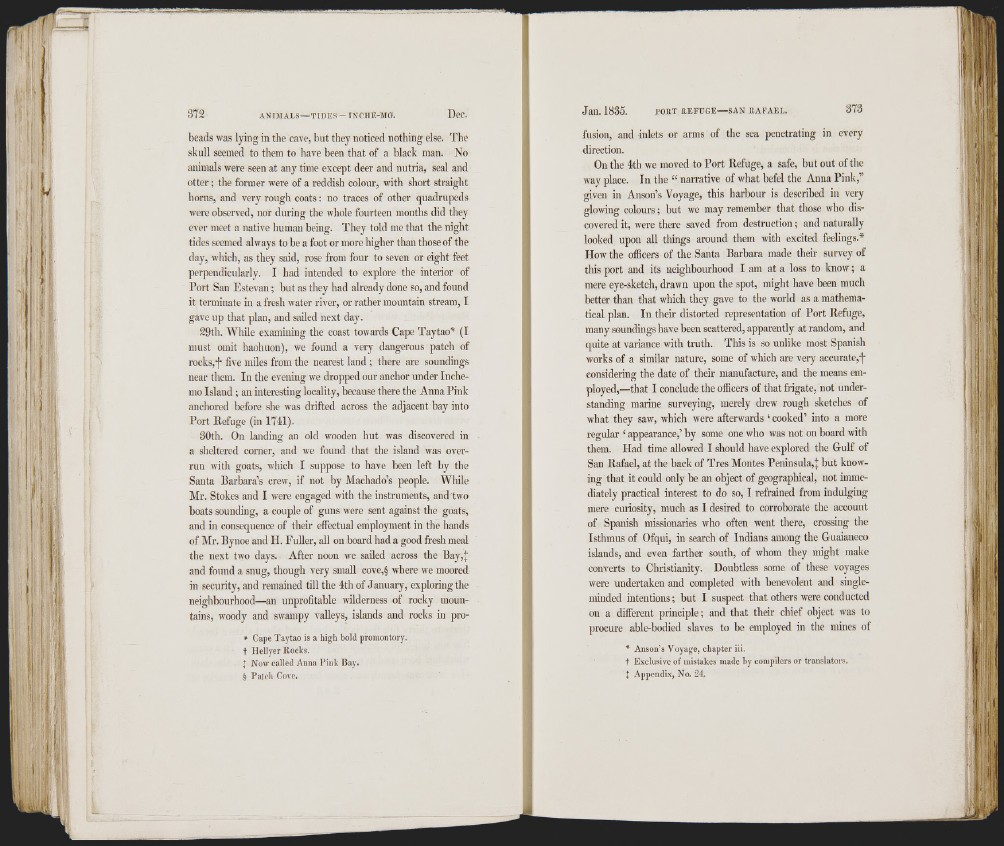
I
I ri
' f
7 1
i if
S I IL
¿7(1
* 7!
■ |
li
i ; ri
beads was lying in the cave, but they noticed nothing else. The
skull seemed to them to have been that of a black man. No
animals were seen at any time except deer and nutria, seal and
otter; the former were of a reddish colour, with short straight
horns, and very rough coats: no traces of other quadrupeds
were observed, nor during the whole fourteen months did they
ever meet a native human being. They told me that the night
tides seemed always to be a foot or more higher than those of the
day, which, as they said, rose from four to seven or eight feet
perpendicularly. I had intended to explore the interior of
Port San Estevan; but as they had already done so, and found
it terminate in a fresh water river, or rather mountain stream, I
gave up that plan, and sailed next day.
29th. While examining the coast towards Cape Taytao* (I
must omit haohuon), we found a very dangerous patch of
rocks,! miles from the nearest land ; there are soundings
near them. In the evening we dropped our anchor under Inche-
mo Island ; an interesting locality, because there the Anna Pink
anchored before she was drifted across the adjacent bay into
Port Refuge (in 1741).
SOth. On landing' an old wooden hut was discovered in
a sheltered corner, and we found that the island was overrun
witli goats, which I suppose to have heen left by the
Santa Barbara’s crew, if not by Machado’s people. While
Mr. Stokes and I were engaged with the instruments, and two
boats sounding, a couple of guns were sent against the goats,
and in consequence of their effectual employment in the hands
of Mr. Bynoe and H. Fuller, all on hoard had a good fresh meal
the next two days. After noon we sailed across the Bay,]
and found a snug, though very small cove,§ where we moored
in security, and remained till the 4th of January, exploring the
neighbourhood—an unprofitable wilderness of rocky mountains,
woody and swampy valleys, islands and rocks in pro-
* Cape Taytao is a high bold promontory.
t Hellyer Rocks.
} Now called Anna Rink Bay.
,§ Patch Cove.
fusion, and inlets or arms of the sea penetrating in every
direction.
On the 4th we moved to Port Refuge, a safe, but out of the
way place. In the “ narrative of what befel the Anna Pink,”
given in Anson’s Voyage, this harbour is described in very
glowing colours ; but we may remember that those who discovered
it, were there saved from destruction ; and naturally
looked upon all things around them with excited feelings.*
How the officers of the Santa Barbara made their survey of
this port and its neighbourhood I am at a loss to know ; a
mere eye-sketch, drawn upon the spot, might have been much
better than that which they gave to the world as a mathematical
plan. In their distorted representation of Port Refuge,
many soundings have been scattered, apparently at random, and
quite at variance with truth. This is so unlike most Spanish
works of a similar nature, some of which are very accurate,!
considering the date of their manufacture, and the means employed,—
that I conclude the officers of that frigate, not understanding
marine surveying, merely drew rough sketches of
what they saw, which were afterwards ‘ cooked’ into a more
regular ‘ appearance,’ by some one who was not on board with
them. Had time allowed I should have explored the Gulf of
San Rafael, at the back of Tres Montes Peninsula,] hut knowing
that it could only be an object of geographical, not immediately
practical interest to do so, I refrained from indulging
mere curiosity, much as I desired to corroborate the account
of Spanish missionaries who often went there, crossing the
Isthmus of Ofqui, in search of Indians among the Guaianeco
islands, and even farther south, of whom they might make
converts to Christianity. Doubtless some of these voyages
were undertaken and completed with benevolent and single-
minded intentions; but I suspect that others were conducted
on a different principle; and that their chief object was to
procure able-bodied slaves to be employed in the mines of
* Anson’s Voyage, chapter iii.
+ Exclusive of mistakes made by compilers or translators.
I Appendix, No. 24.